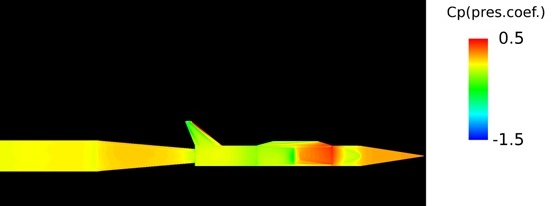Study of Space Transportation Technology (Integrated Design of Airframe and Engine)
JAXA Supercomputer System Annual Report April 2016-March 2017
Report Number: R16E0073
- Responsible Representative: Koichi Okita(Research and Development Directorate, Unit IV)
- Contact Information: Susumu Hasegawa(hasegawa.susumu@jaxa.jp)
- Members: Takeshi Kanda
- Subject Category: Space(Rocket,Rocket engine,Space transportation)
Abstract
Integrated design technology of Spaceplane and its engine for future space transportation is studied, and conceptual design technology will be established. Wind tunnel tests, CFD simulation and conceptual study for estimation of transportation ability are conducted. The spaceplanes have larger thrust and larger engines than the planes have. Therefore, aerodynamic characteristics of the spaceplanes interacts with the engine thrust and the engine integration. In the study, stability is a key issue, as well as the transportation ability and economical efficiency.
Goal
Establishment of integrated design technology of spaceplane and its engine for future space transportation.
Objective
Establishment of integrated design method of airframe and its engine of spaceplane in aerodynamics and their integration.
References and Links
N/A
Use of the Supercomputer
Pre calculation is conducted for wind tunnel tests, and the calculated results are used for discussion on the test results. After certification of the CFD results by the test data, simulation calculation is conducted for other conditions, too.
Necessity of the Supercomputer
Numbers, conditions and measured data of the wind tunnels are limited, so CFD simulation is necessary. Especially, 3D flow simulation needs fast calculation with large memory. It can be conducted only with a supercomputer.
Achievements of the Year
Pre-calculation of the test model was conducted for preparation of the wind tunnel tests, and the calculation results are used for discussion on the experimental tests. Some calculated results agreed with the experimental ones, and others are not. The established CFD simulation procedure will be used to improve configurations and operating conditions of the spaceplane and its engines.
Publications
Presentations
1) Susumu Hasegawa, Takeshi Kanda,’Preliminary Numerical Simulation of Flow around Spaceplane for Airframe Engine Integration’, ISTS 31th, Matsuyama, Japan, Jun 9, 2017.
Computational Information
- Parallelization Methods: Process Parallelization
- Process Parallelization Methods: MPI
- Thread Parallelization Methods: n/a
- Number of Processes: 128
- Number of Threads per Process: 1
- Number of Nodes Used: 4
- Elapsed Time per Case (Hours): 256
- Number of Cases: 60
Resources Used
Total Amount of Virtual Cost(Yen): 23,211
Breakdown List by Resources
| System Name | Amount of Core Time(core x hours) | Virtual Cost(Yen) |
|---|---|---|
| SORA-MA | 0.00 | 0 |
| SORA-PP | 716.45 | 6,117 |
| SORA-LM | 0.00 | 0 |
| SORA-TPP | 0.00 | 0 |
| File System Name | Storage assigned(GiB) | Virtual Cost(Yen) |
|---|---|---|
| /home | 9.54 | 79 |
| /data | 95.37 | 792 |
| /ltmp | 1,953.13 | 16,223 |
| Archiving System Name | Storage used(TiB) | Virtual Cost(Yen) |
|---|---|---|
| J-SPACE | 0.00 | 0 |
Note: Virtual Cost=amount of cost, using the unit price list of JAXA Facility Utilization program(2016)
JAXA Supercomputer System Annual Report April 2016-March 2017



